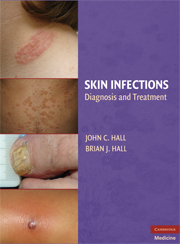Book contents
- Frontmatter
- Contents
- List of Contributors
- Acknowledgments
- INTRODUCTION
- TECHNIQUES IN DIAGNOSING DERMATOLOGIC MANIFESTATIONS OF INFECTIOUS DISEASES
- PRINCIPLES OF MANAGEMENT OF DERMATOLOGIC INFECTIONS IN THE SKIN
- PART 1 COMMON INFECTIONS
- PART II LESS COMMON INFECTIONS
- PART III INFECTIONS IN SELECTED ECOSYSTEMS
- 10 INFECTIONS IN THE DESERT
- 11 INFECTION IN THE TROPICS
- 12 AQUATIC DERMATOLOGY
- PART IV INFECTIONS IN SELECTED PATIENT POPULATIONS
- PART V INFECTIONS OF SPECIFIC SKIN-ASSOCIATED BODY SITES
- PART VI SPECIAL DISEASE CATEGORIES
- Index
10 - INFECTIONS IN THE DESERT
from PART III - INFECTIONS IN SELECTED ECOSYSTEMS
Published online by Cambridge University Press: 08 January 2010
- Frontmatter
- Contents
- List of Contributors
- Acknowledgments
- INTRODUCTION
- TECHNIQUES IN DIAGNOSING DERMATOLOGIC MANIFESTATIONS OF INFECTIOUS DISEASES
- PRINCIPLES OF MANAGEMENT OF DERMATOLOGIC INFECTIONS IN THE SKIN
- PART 1 COMMON INFECTIONS
- PART II LESS COMMON INFECTIONS
- PART III INFECTIONS IN SELECTED ECOSYSTEMS
- 10 INFECTIONS IN THE DESERT
- 11 INFECTION IN THE TROPICS
- 12 AQUATIC DERMATOLOGY
- PART IV INFECTIONS IN SELECTED PATIENT POPULATIONS
- PART V INFECTIONS OF SPECIFIC SKIN-ASSOCIATED BODY SITES
- PART VI SPECIAL DISEASE CATEGORIES
- Index
Summary
Deserts make up over one-fifth of the earth's land surface. These areas have traditionally been defined as regions with low precipitation, <10 inches (<250 mm) annually. Potential evapotranspiration, in conjunction with precipitation levels, may more accurately delineate desert regions as it reflects the amount of water the atmosphere removes from the earth's surface. For example, the Tucson, Arizona area, which slightly exceeds 10 inches of rainfall annually, experiences evaporation that can be eight times higher than that amount. Nonpolar deserts are typically hot, have low humidity, and are characterized by extremes of their diurnal temperature range (high during the daylight, relatively low during the nighttime). The terrain of these dry regions is often dominated by sand and rocky surfaces with sparse vegetation.
There are two main infectious diseases of dermatologic significance that occur primarily in, or adjacent to the ariddesert regions of the globe: Old World cutaneous leishmaniasis and coccidioidomycosis. The former is limited to the Eastern Hemisphere, while the latter is limited to the Western Hemisphere. There is a striking absence of either disease occurring naturally in the opposite hemisphere, and they are discussed separately here.
EASTERN HEMISPHERE: OLD WORLD CUTANEOUS LEISHMANIASIS
Leishmaniasis is a protozoal infection transmitted by the bite of a sandfly. The three main clinical syndromes are cutaneous, mucocutaneous, and visceral infections. The cutaneous leishmaniasis (CL) presentation is most common, with the World Health Organization estimating 1.5 million cases each year.
- Type
- Chapter
- Information
- Skin InfectionsDiagnosis and Treatment, pp. 135 - 149Publisher: Cambridge University PressPrint publication year: 2009



